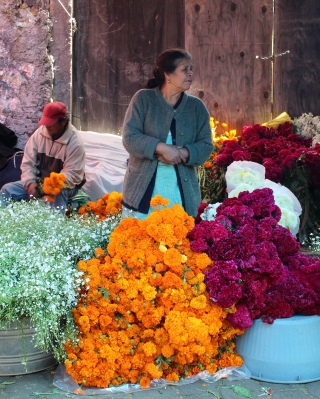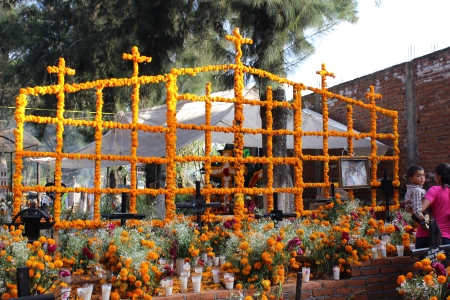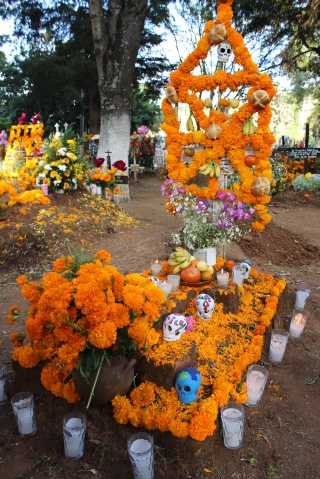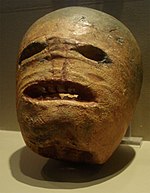This question doesn't even come up in Mexico's traditional, rural regions, but it's increasingly relevant in Mexico's urban settings, where television and the supermarkets have introduced the trappings of Halloween into Mexican culture. Along the culturally porous frontier region between Mexico and its northern neighbor, of course, this is indeed an intriguing question.
Halloween: Western European Tradition
Halloween, or Hallowe'en — a contraction of "All Hallows’ Evening" — is also known as Allhalloween, All Hallows' Eve, or All Saints' Eve. Regardless of what it's called, it is a yearly celebration observed in a number of countries on October 31, eve of the Western Christian feast of All Hallows' (Saints') Day that begins the three-day observance of Allhallowtide — the season in the liturgical year dedicated to remembering the dead, including saints (hallows), martyrs, and all the faithful departed believers.
Pre-Christian Roots
All Hallows' Eve is influenced by Celtic harvest festivals, particularly the Gaelic festival Samhain (pronounced /
sah-win or
sow-in), which marks the end of the harvest season and the beginning of winter or the year's "darker half". Traditionally, Samhain is celebrated from sunset on October 31 to sunset on November 1, which puts it about halfway between the Autumn Equinox (September 21) and the Winter Solstice (December 21).
Evidence exists that Samhain has been an important date since ancient times. It is mentioned in some of the earliest Irish literature, and many important events in Irish mythology take place or begin on Samhain. It was the time when cattle were brought back down from the summer pastures, and livestock were slaughtered for the winter.
Special bonfires were ritually lit. The bonfires' flames, smoke and ashes were deemed to have protective and cleansing powers and were also used for divination, especially regarding death and marriage. Some suggest the fires were a kind of imitative or sympathetic magic — they mimicked the Sun, helping the "powers of growth" and holding back the decay and darkness of the coming winter.
Samhain was seen as a liminal time; that is, when the boundary between this world and the Otherworld thinned and hence could more easily be crossed. This meant the 'spirits' or 'fairies' — Aos Sí (pronounced / ees shee) — could come into our world. At Samhain it was believed that the Aos Sí — gods and nature spirits — needed to be propitiated to ensure that the people and their livestock would survive the harsh winter. Offerings of food and drink were left outside for them.
The souls of the dead were thought to revisit their homes seeking hospitality. Feasts were held, and souls of dead kin were beckoned to attend. A place was set for them at the table and a spot was reserved for them by the bonfire.
Mumming (seasonal folk plays performed by troupes of actors) was part of the festival, as was guising, when people went door-to-door in costume (disguise), often reciting verses in exchange for food. The costumes may have been a way of imitating, and disguising oneself from, the Aos Sí. Impersonating these beings, or wearing a disguise, was believed to protect oneself from them. It is suggested that the mummers and guisers
"personify the old spirits of the winter, who demanded reward in exchange for good fortune."
"It was traditionally believed that the souls of the departed wandered the earth until All Saints' Day, and All Hallows' Eve provided one last chance for the dead to gain vengeance on their enemies before moving to the next world. In order to avoid being recognized by any soul that might be seeking such vengeance, people would don masks or costumes to disguise their identities."
From at least the 18th century, "imitating malignant spirits" led to playing pranks in Ireland and the Scottish Highlands. In the 20th century, wearing costumes and playing pranks at Halloween spread to England.
The
"traditional illumination for guisers or pranksters abroad on the night in some places was provided by turnips, hollowed out to act as lanterns and often carved with grotesque faces."
Those who made them said the lanterns were to represent the spirits or, alternatively, to ward off evil spirits. They were common in parts of Ireland and the Scottish Highlands in the 19th century. In the 20th century they spread to other parts of England and became generally known as Jack-o'-Lanterns, which in North America are carved from pumpkins.
Christian Influences
Today's Halloween customs are also thought to have been influenced by Christian dogma and practices derived from it. Since the time of the early Church, major feasts in the Christian Church (such as Christmas, Easter and Pentecost) had vigils that began the night before, as did the feast of All Hallows'. Collectively referred to as Allhallowtide, these three days — eve of October 31 to sunset on November 2 — are a time for honoring the saints and praying for the recently departed souls who have yet to reach Heaven.
Introduced in the year 609, All Saints was originally celebrated on May 13, the same date as Lemuria, an ancient Roman festival of the dead. In 835, at the behest of Pope Gregory IV, All Saints was officially switched to November 1, the same date as Samhain. Some suggest this was due to Celtic influence; others suggest it was a Germanic idea. It is claimed that both Germanic and Celtic-speaking peoples commemorated the dead at the beginning of winter, which may have been seen as the most fitting time to do so, since that was when the plants themselves were 'dying'.
By the end of the 12th century the three days of Allhallowtide had become holy days of obligation across Europe and involved such traditions as ringing church bells for the souls in purgatory. In addition,
"it was customary for criers dressed in black to parade the streets, ringing a bell of mournful sound and calling on all good Christians to remember the poor souls."
In medieval Europe at Halloween,
"fires [were] lit to guide these souls on their way and deflect them from haunting honest Christian folk."
Households in Austria, England and Ireland often had
"candles burning in every room to guide the souls back to visit their earthly homes."
'Souling', the custom of baking and sharing soul cakes (a small, round traditional cake) for all christened souls, has been suggested as the origin of Trick-or-Treating. The custom dates at least as far back as the 15th century and was found in parts of England, Flanders, Germany and Austria. Groups of poor people, often children, would go door-to-door during Allhallowtide, collecting soul cakes in exchange for praying for the dead, especially the souls of the givers' friends and relatives. Soul cakes would also be offered for the souls themselves to eat, or the 'soulers' would act as their representatives.
Halloween Customs in North America
The practice of guising at Halloween in North America doesn't appear until 1911, when a Kingston, Ontario, newspaper reported children going "guising" around the neighborhood. Another reference to ritual begging on Halloween appears, place unknown, in 1915, and a third shows up in Chicago in 1920.
Trick-or-Treat is a customary Halloween celebration for children, who go house to house in costume, asking for treats such as candy or sometimes money, with the question, "Trick or Treat?" The word "trick" refers to "threat" to perform mischief on the homeowners or their property if no treat is given. But it turns out that Trick-or-Treat may be a 20th century invention. The earliest known use in print of the term "Trick or Treat" appears in 1927, in the Blackie Herald of Alberta, Canada.
American historian Ruth Edna Kelley of Massachusetts wrote the first history of Halloween in the U.S.,
The Book of Hallowe'en (1919). In the chapter "Hallowe'en in America", Kelley describes
souling and has this to say on customs that arrived from across the Atlantic:
"Americans have fostered them, and are making this an occasion something like what it must have been in its best days overseas. All Halloween customs in the United States are borrowed directly or adapted from those of other countries."
Between the turn of the 20th century and the 1920s, thousands of Halloween postcards were produced showing children, but not
Trick-or-Treating, which doesn't seem to have become a widespread practice until the 1930s. The term first appeared in the U.S. in 1934, and its first use in a national publication occurred in 1939.
Día de los Muertos / Day of the Dead: Mesoamerican Roots
Original peoples in South Central Mexico and North Central America (Mesoamerica) are known for having "very elaborate forms of spirituality" linked to the annual agricultural cycle grounded in the sun's annual passage across the heavens.
Mexico's geography, climate and natural forces, are very different from Europe's. The vulnerability of this land's early inhabitants to the vicissitudes of natural phenomena — volcanic eruptions, earthquakes, cyclones from the Pacific, hurricanes from the Caribbean and Atlantic, landslides, floods, and drought — honed in them a keen awareness that they were indeed not in charge; in fact, they were at the mercy of la naturaleza (forces of nature). The Mesoamerican worldview has been described like this:
"Rather than imagining a god separate from his creation, the thinkers of Mesoamerica conceived of the divine as the Life-Force itself, constantly creating, ordering, sustaining, destroying and recreating the world."
The Mesoamerican peoples perceived the cosmos as centered on the human world at the earthly level, around which the sun revolved in its daily cycle, rising to the zenith of Heaven, then descending into night and the Underworld. These themes appear in the design of the altars or
ofrendas, offerings, that reproduce the Mesoamerican cosmovisión ("worldview"). The altars represent the
- Underworld [ground level], where incensarios (censers burning copal) are placed; the
- Earthly level [midpoint], where offerings [bread, fruit, water, salt, tequila, cerveza] are placed; and the
- Heavens [upper level], with images and photographs of the dead.
 |
Ofrenda, Offering, in private home;
a neighbor is placing her gift of fruit |
The altars, characterized in most cases by their bright colors, are complete with copal incense and sweet drinks fermented from corn, chocolate, typical dishes like pumpkin or sweet tamales. It is customary to place the names of the deceased with their photographs.
"Here, what appears is a celebration of Life, there is a joy in being connected with the dead. (...) I believe that it is the end of a human cycle that is lived with great joy," observed Andrés Merino, a member of the Institute of Anthropological Research at the National Autonomous University of Mexico (UNAM) .
During this celebration, in addition to going to the cemeteries, children often go out on the streets to sing praises and ask offerings on behalf of the dead, with a
chilacayote (a fruit similar to pumpkin) with a candle inside. Dr. Merino believes this custom leads to confusing
Día de los Muertos with Halloween.
Spanish Catholic Influences
The Catholic Hispanic legacy is seen, for example, in the
pan de muerto [
bread of the dead], made with wheat flour [
introduced by the Spanish], eggs, sugar and anise; in the placement of fruits and flowers not native to the region [
also brought by the Spanish] on altars, and in the use of candles and such Christian concepts as "souls" in referring to the dead who return this one night in the year.
Same, Different, Little of Each?
At first glance, Halloween and
Día de los Muertos are similar. Both relate to the agricultural cycle, itself linked to the sun's annual journey, and both occur at the midpoint between the Autumnal Solstice and the Winter Equinox. The belief that the souls of the dead return home on one night of the year seems to have ancient origins; it is found in many cultures throughout the world but, as the saying goes, 'the devil is in the details'.
The European harvest festival was motivated by anticipation of the "dark part" of the year and the fervant desire to gain protection against it. However, Mexico's unique geography and the Mesoamerican
cosmovisión that grew up in response to the natural challenges faced by Mexico's early peoples gave rise to both a form and meaning of
Día de los Muertos that is quite distinct from the symbolism of Halloween.
Nonetheless, the medieval Spanish Catholic legacy that is part of Mexican culture in general and
Día de los Muertos in particular does share common elements with the tradition of Halloween. This becomes more understandable when we realize that the region inhabited by the
Celts included a large part of the Iberian Peninsula (Spain).
The
pan de muerto, for example, is similar to the
soul cakes that are part of Halloween, as is the use of candles and reference to such Christian concepts as "souls" for referring to the dead who return on this one night.
 |
Pan de Muerto / Bread of Death in shape of human with crossed arms
Photo: Reed |
As as it did in Europe, human welfare in Mexico depended on the agricultural cycle for producing successful corn crops, which culminated with the "harvest festival" or "festival of the dead" presided over by the goddess Mictecacíhuatl, known as
Lady Death, and her husband Mictlantecuhtli,
Lord of the Land of the Dead. Today,
Lady Death is represented as
La Catrina, the character created by graphic artist
José Guadalupe Posada and made popular by his disciple and friend, Mexican muralist Diego Rivera.
 |
La Catrina is in center in this detail from Diego Rivera's
Sueño de la tarde dominical en la Alameda Central /
Dream of a Sunday Afternoon in Alameda Central (1947)
|
Mexico / United States
Mexico and the United States are a single geological region, increasingly linked economically, socially and culturally. What better way, then, to introduce the cross-border cultural influence — which today pretty much runs in both directions — than by presenting
Tucson Artist Hank Tusinski's ~:BANDA CALACA:~ now at the Tucson Museum of Art until January 3, 2016.
The work features a nearly life-size, 15-piece free-standing papier mâche skeleton mariachi band with musical instruments on an installation about 12 feet high, 25 feet long, and 6 feet wide. The work is unusual given that Tusinski is a devout Zen Buddhist:
"Tusinski’s work focuses on integrating the beliefs of Mesoamerica, Mexican contemporary indigenous communities, and contemporary Buddhists about death as a transformational process to be celebrated. A journey to Michoacán, Mexico, introduced Tusinski to the indigenous P΄urhépecha peoples’ use of music in their Festival of the Spirit as an embodiment of spirit. This is the well-spring of ~:BANDA CALACA:~."
Tusinski says
“The fundamental dilemma of existence is the nature of life and death. There is potential liberation and joy in death. ~:BANDA CALACA:~ is offered with the intention of creating the opportunity to view this transition as energy that continues infinitely. The skeleton band represents the individual and the universal dance in the eternal flow.”
Dr. Julie Sasse, TMA Chief Curator and Curator of Modern and Contemporary Art, said:
“Tusinski’s ~:BANDA CALACA:~ is a riot of color, pattern, and imagery. His work reminds us to celebrate life in death, to honor the past in the present, and to embrace the universality of spiritual openness.”
~:BANDA CALACA:~ ... an energetic representation of the Life-Force itself ...
 |
~:BANDA CALACA:~
Hank Tusinski
Photo: Courtesy of the Artist |


























































